Lisbon
Portugal
Introduction
Portuguese Lisboa
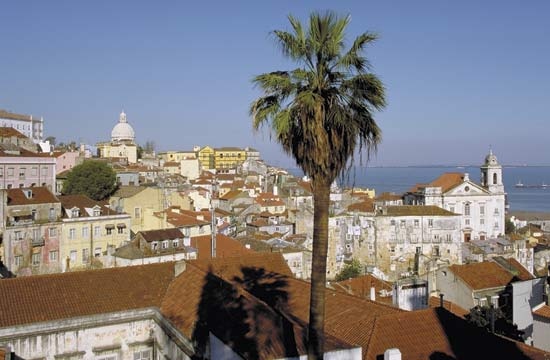
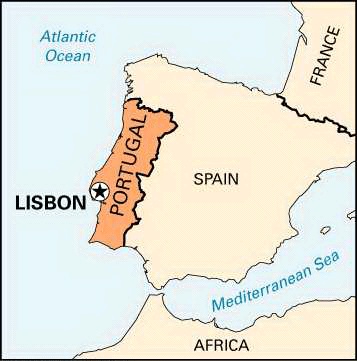 city, port, and capital of Portugal, as well as the centre of the Lisbon metropolitan area. Located in western Portugal, it is the westernmost capital city in continental Europe and serves as the country's chief port, largest city, and commercial, political, and tourist centre. The city's name is a modification of the ancient Olisipo (Ulyssipo), and its founding has been attributed to the legacy of Ulysses ( Odysseus), the hero of Homer's Odyssey; to Elisha, grandson of the Hebrew patriarch Abraham; and, more credibly, to Phoenician colonists. Lisbon owes its historical prominence to its natural harbour, one of the most beautiful in the world. Area city, 33 square miles (85 square km). Pop. (2001) city, 564,657; metropolitan area, 2,661,850.
city, port, and capital of Portugal, as well as the centre of the Lisbon metropolitan area. Located in western Portugal, it is the westernmost capital city in continental Europe and serves as the country's chief port, largest city, and commercial, political, and tourist centre. The city's name is a modification of the ancient Olisipo (Ulyssipo), and its founding has been attributed to the legacy of Ulysses ( Odysseus), the hero of Homer's Odyssey; to Elisha, grandson of the Hebrew patriarch Abraham; and, more credibly, to Phoenician colonists. Lisbon owes its historical prominence to its natural harbour, one of the most beautiful in the world. Area city, 33 square miles (85 square km). Pop. (2001) city, 564,657; metropolitan area, 2,661,850.Character of the city
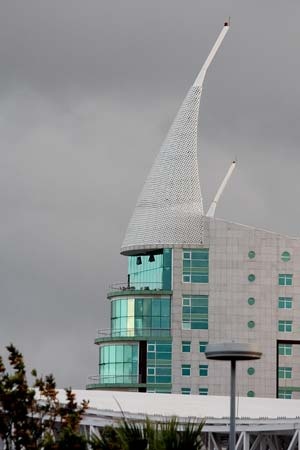 Once a remote outpost on what was thought to be the farthest edge of the known world, Lisbon established itself as a centre of operations for Portuguese exploration by the 15th century. The city centre was destroyed by an earthquake in 1755 but was rebuilt by the marquês de Pombal (Pombal, Sebastião de Carvalho, marquês de) (see Lisbon earthquake of 1755). This seagirt city of multicoloured houses and elegant parks and gardens is no longer the capital of a vast overseas empire. It has been reconstructed as a bustling modern metropolis. In fact, Lisbon was designated a European City of Culture in 1994 and in 1998 hosted the World's Fair (Expo '98), which sparked the city's biggest renewal project since the rebuilding that followed the 1755 earthquake, including the construction of the combined road-rail Vasco da Gama Bridge and other extensive upgrades of the city's transportation infrastructure. The fair also was the primary catalyst for the construction along the Tagus River of an oceanarium, marinas, hotels, commercial complexes, and entertainment venues.
Once a remote outpost on what was thought to be the farthest edge of the known world, Lisbon established itself as a centre of operations for Portuguese exploration by the 15th century. The city centre was destroyed by an earthquake in 1755 but was rebuilt by the marquês de Pombal (Pombal, Sebastião de Carvalho, marquês de) (see Lisbon earthquake of 1755). This seagirt city of multicoloured houses and elegant parks and gardens is no longer the capital of a vast overseas empire. It has been reconstructed as a bustling modern metropolis. In fact, Lisbon was designated a European City of Culture in 1994 and in 1998 hosted the World's Fair (Expo '98), which sparked the city's biggest renewal project since the rebuilding that followed the 1755 earthquake, including the construction of the combined road-rail Vasco da Gama Bridge and other extensive upgrades of the city's transportation infrastructure. The fair also was the primary catalyst for the construction along the Tagus River of an oceanarium, marinas, hotels, commercial complexes, and entertainment venues.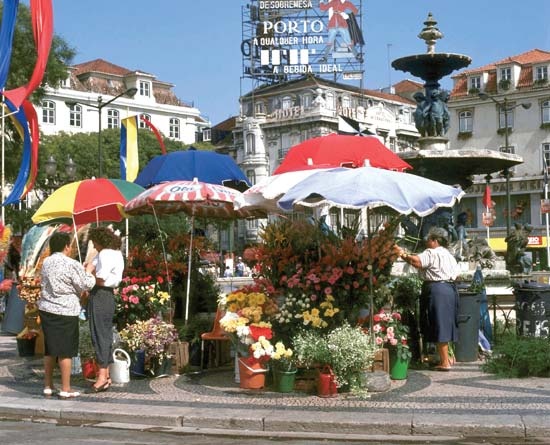 Despite modernization, Lisbon in many ways retains the air of a 19th-century city. The varinas (fish vendors) who roam the streets dressed in long black skirts still carry their wares in baskets on their heads. Vessels tie up at quays where the clang of trolley cars blends with ships' horns. At dawn, fishing boats deposit their catch for noisy auction with Lisbon shop owners, while the fish vendors wait to fill the baskets they peddle through the streets. Farther inland, the fish market gives way to the equally colourful and clamorous fruit and vegetable market. Lisbon's port also maintains an intimacy with its city that was common in the days before steam. Amid the freighters, warships, cruise liners, and ferryboats, a picturesque note is struck by the fragatas of Phoenician origin; these crescent-shaped boats with their striking black hulls and pink sails still perform most of the harbour's lighterage.
Despite modernization, Lisbon in many ways retains the air of a 19th-century city. The varinas (fish vendors) who roam the streets dressed in long black skirts still carry their wares in baskets on their heads. Vessels tie up at quays where the clang of trolley cars blends with ships' horns. At dawn, fishing boats deposit their catch for noisy auction with Lisbon shop owners, while the fish vendors wait to fill the baskets they peddle through the streets. Farther inland, the fish market gives way to the equally colourful and clamorous fruit and vegetable market. Lisbon's port also maintains an intimacy with its city that was common in the days before steam. Amid the freighters, warships, cruise liners, and ferryboats, a picturesque note is struck by the fragatas of Phoenician origin; these crescent-shaped boats with their striking black hulls and pink sails still perform most of the harbour's lighterage.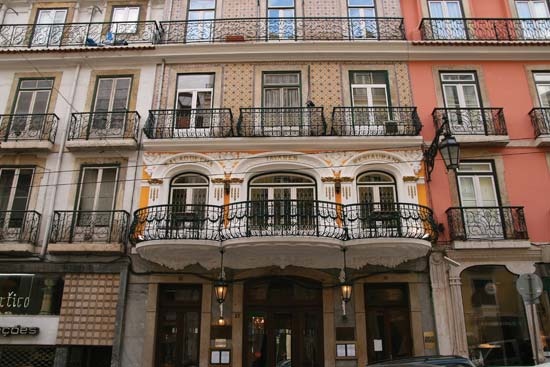 The general outlines of the city remain as they have for hundreds of years. Lisbon is still a city of balconies and vistas. Some of the most striking of the latter can be seen from the miradouros, the terraces maintained by the municipality on seven of its hillsides. (Many Lisboetas, as the people of Lisbon are known, profess their city to have seven traditional hills, like Rome.) For centuries Lisboetas have discussed the symptoms of an affliction they believe to be endemic in their city: saudade (“melancholy”), a state of anxiety tempered by fatalism that is said to be reflected in fado (“fate”), the melodic but deeply emotional folk songs that can still be heard in specific restaurants, mainly in the historic quarters of Alfama and Bairro Alto.
The general outlines of the city remain as they have for hundreds of years. Lisbon is still a city of balconies and vistas. Some of the most striking of the latter can be seen from the miradouros, the terraces maintained by the municipality on seven of its hillsides. (Many Lisboetas, as the people of Lisbon are known, profess their city to have seven traditional hills, like Rome.) For centuries Lisboetas have discussed the symptoms of an affliction they believe to be endemic in their city: saudade (“melancholy”), a state of anxiety tempered by fatalism that is said to be reflected in fado (“fate”), the melodic but deeply emotional folk songs that can still be heard in specific restaurants, mainly in the historic quarters of Alfama and Bairro Alto.Landscape
City site
The city lies on the north bank of the Tagus River, about 8 miles (13 km) from the river's entrance into the Atlantic Ocean. From the ocean upstream to the city, the river is almost straight and about 2 miles (3 km) wide. It is spanned, on the west side of the city, by the 25th of April Bridge. Just east of the bridge, the Tagus suddenly broadens into a bay 7 miles (11 km) wide called the Mar de Palha (“Sea of Straw”) because of the way that it shimmers in the sun. Scenically spectacular, this hill-cradled bay of burnished water lies on a strategic sea route and serves as a busy port, handling much of the trade between Portugal and Spain.
Lisbon is built in a succession of terraces up the slopes of a range of low rolling hills that rise from the banks of the Tagus River and the Mar de Palha northwest toward the Sintra Mountains, whose covering of lush Mediterranean and Atlantic European flora provides an attractive retreat for the city's population. Sections of the city vary considerably in elevation, especially in the older areas along the water's edge, which offer splendid views of the river and the low cliffs that line the river's southern shore. Several geologic faults cross Lisbon and the surrounding region, but, notwithstanding the devastating earthquake of 1755, seismic activity has been limited to slight tremors since the 20th century.
Climate
Lisbon has a mild and equable climate, with a mean annual temperature in the low 60s F (about 17 °C). The proximity of the Atlantic Ocean and the influence of the Gulf Stream mediate the weather conditions throughout the year. January, the coldest month, has an average temperature of 50 °F (10 °C), and in August the temperature seldom exceeds 82 °F (28 °C). Average monthly rainfall ranges from 0.1 inch (3 mm) in summer up to about 4 inches (100 mm) in winter.
City layout
It is traditional for poets to refer to the entwining Tagus (Tagus River) as Lisbon's lover. The river is indeed an ever-present part of the city's decor, and the official entrance to Lisbon is a broad marble staircase mounting from the water to the vast, arcaded Commerce Square (Praça do Comércio). The three landward sides of the square are surrounded by uniform buildings dating from the 18th century. This formal, Baroque-inspired layout is pierced by a monumental archway, built a century later, marking the entry north into the central city. In the middle of the square stands a bronze statue of King Joseph I (Joseph) on horseback, an important work by the sculptor Joachim Machado de Castro. Many government offices occupy the buildings that surround Commerce Square.
 The square lies at the south end of Lisbon's central district, the Cidade Baixa (“Lower City”). The Baixa was completely rebuilt after the earthquake in 1755 under the supervision of Joseph I's prime minister, Sebastião de Carvalho (Pombal, Sebastião de Carvalho, marquês de), later the marquês de Pombal. The streets are laid out in a grid pattern broken by spacious squares. A series of parallel streets, each named for its original intended occupants (e.g., Rua Áurea 【“Golden Street”】 for the goldsmiths), runs north from Commerce Square to Dom Pedro IV Square, locally known as Rossio Square. Rossio Square is a traditional centre of activity and the starting point of the city's main promenade, the wide, gently sloping Avenida da Liberdade. This treelined boulevard leads north from the city centre to Marquês de Pombal Circle, which features a statue of Pombal. The Baixa remains rigorously protected from change, but the four-story buildings that long lined Avenida da Liberdade and its ancillary streets have been almost totally replaced by taller edifices in a bland, modern style.
The square lies at the south end of Lisbon's central district, the Cidade Baixa (“Lower City”). The Baixa was completely rebuilt after the earthquake in 1755 under the supervision of Joseph I's prime minister, Sebastião de Carvalho (Pombal, Sebastião de Carvalho, marquês de), later the marquês de Pombal. The streets are laid out in a grid pattern broken by spacious squares. A series of parallel streets, each named for its original intended occupants (e.g., Rua Áurea 【“Golden Street”】 for the goldsmiths), runs north from Commerce Square to Dom Pedro IV Square, locally known as Rossio Square. Rossio Square is a traditional centre of activity and the starting point of the city's main promenade, the wide, gently sloping Avenida da Liberdade. This treelined boulevard leads north from the city centre to Marquês de Pombal Circle, which features a statue of Pombal. The Baixa remains rigorously protected from change, but the four-story buildings that long lined Avenida da Liberdade and its ancillary streets have been almost totally replaced by taller edifices in a bland, modern style.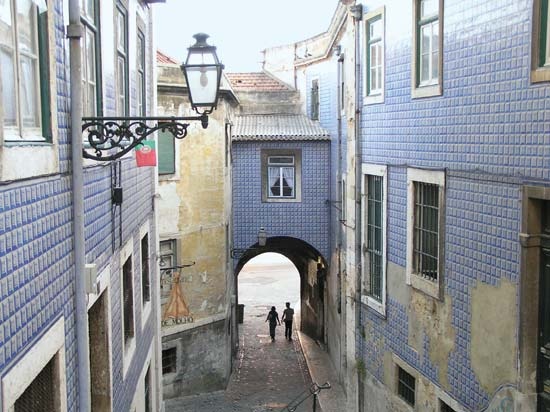 In the sequence of post-earthquake reconstruction, the waterfront's renovation was followed by the rehabilitation of historical districts, such as Castelo, Alfama, Bairro Alto, Mouraria, and Madragoa, and fashionable residential areas, such as Chiado, Lapa, Estrela, and Príncipe Real. In 1988 a fire destroyed part of the city's historic Chiado district, which was rebuilt as a shopping area during the 1990s. Rua Garrett in Chiado is lined with boutiques, silver and porcelain shops, cafés, and bookstores. Peripheral neighbourhoods, such as Ajuda to the west, Rato-Amoreiras to the north, and Graça to the east, were also planned at this time.
In the sequence of post-earthquake reconstruction, the waterfront's renovation was followed by the rehabilitation of historical districts, such as Castelo, Alfama, Bairro Alto, Mouraria, and Madragoa, and fashionable residential areas, such as Chiado, Lapa, Estrela, and Príncipe Real. In 1988 a fire destroyed part of the city's historic Chiado district, which was rebuilt as a shopping area during the 1990s. Rua Garrett in Chiado is lined with boutiques, silver and porcelain shops, cafés, and bookstores. Peripheral neighbourhoods, such as Ajuda to the west, Rato-Amoreiras to the north, and Graça to the east, were also planned at this time.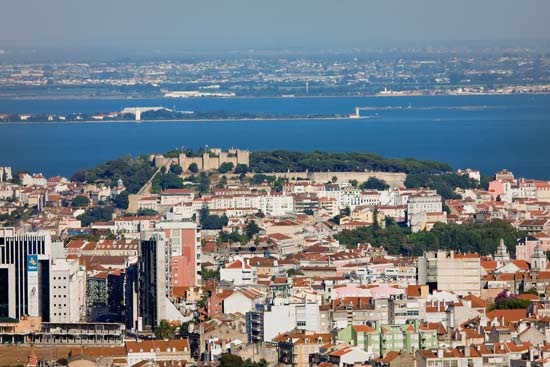 Directly east of the Baixa lies Alfama (Arabic: Al-Ḥammah; “Hot Spring”); one of the oldest quarters of the city, it has a blend of Roman and Moorish architecture and narrow streets that crowd between a jumble of houses down to the river. In this area, on the hill where Lisbon was first founded, the Castle of St. George (Castelo de São Jorge) towers over the city. The castle is Moorish in origin and was named for England's patron saint, in honour of an alliance made in 1386 between Portugal and England. Just below it, the austere white church and monastery of St. Vincent guards the remains of the saint, which (according to legend) were miraculously brought to the city in a ship guided by two ravens. To commemorate the event, the birds are depicted on the Lisbon coat of arms.
Directly east of the Baixa lies Alfama (Arabic: Al-Ḥammah; “Hot Spring”); one of the oldest quarters of the city, it has a blend of Roman and Moorish architecture and narrow streets that crowd between a jumble of houses down to the river. In this area, on the hill where Lisbon was first founded, the Castle of St. George (Castelo de São Jorge) towers over the city. The castle is Moorish in origin and was named for England's patron saint, in honour of an alliance made in 1386 between Portugal and England. Just below it, the austere white church and monastery of St. Vincent guards the remains of the saint, which (according to legend) were miraculously brought to the city in a ship guided by two ravens. To commemorate the event, the birds are depicted on the Lisbon coat of arms.Also to the east, Chelas and Olivais-Sul, two public housing districts implanted on heathland previously considered too difficult to build upon, provide residence for lower-income families. Despite these government-sponsored projects, adequate housing remains a problem as an influx of immigrants (mainly Africans, eastern Europeans, and Brazilians) has caused a housing deficit.
A number of neighbourhoods extend west of the Baixa toward the suburb of Belém. Each possesses its own distinctive character, reflecting the epoch in which it was built. The Bairro Alto (“Upper District”), for example, dates primarily from the 16th century. It is characterized by its maze of straight and narrow streets. Some of these streets, especially those leading down to the Baixa, are so steep that they terminate abruptly, giving way to stairs, cable cars, and, in one case, an elevator (the Santa Justa Lift; an iron structure designed by French architect Raoul Mesnier du Ponsard). Just west and north of the heart of Bairro Alto is the Palace of the National Assembly, also known as the Palace of São Bento. Nearby is the official residence of Portugal's prime minister. Farther west, toward Belém, Necessidades Palace houses the Ministry of Foreign Affairs.
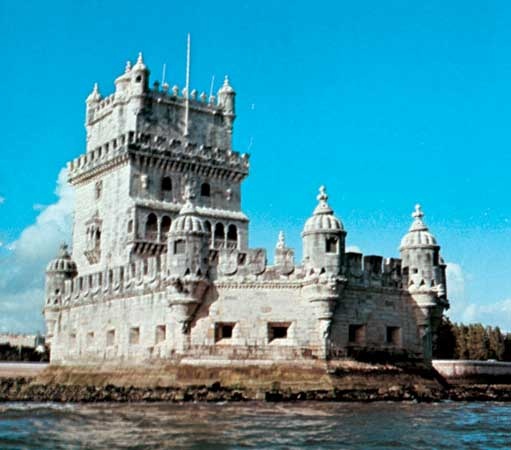
 The Belém Palace, a former royal residence, is the official home of the president of the republic. The Belém area reflects Portugal's maritime past and is known for its Manueline (early 16th-century) architecture, notably the Jerónimos Monastery, founded by Manuel I in 1499, and the Tower of Belém (1515–21; designated a World Heritage site in 1983), which was built to defend the city. The Monument to the Discoveries (1960) on the Tagus River commemorates Portuguese explorers of the 15th and 16th centuries. The Belém-Restelo district, a sumptuous residential area in the western periphery, developed from the 1940s.
The Belém Palace, a former royal residence, is the official home of the president of the republic. The Belém area reflects Portugal's maritime past and is known for its Manueline (early 16th-century) architecture, notably the Jerónimos Monastery, founded by Manuel I in 1499, and the Tower of Belém (1515–21; designated a World Heritage site in 1983), which was built to defend the city. The Monument to the Discoveries (1960) on the Tagus River commemorates Portuguese explorers of the 15th and 16th centuries. The Belém-Restelo district, a sumptuous residential area in the western periphery, developed from the 1940s.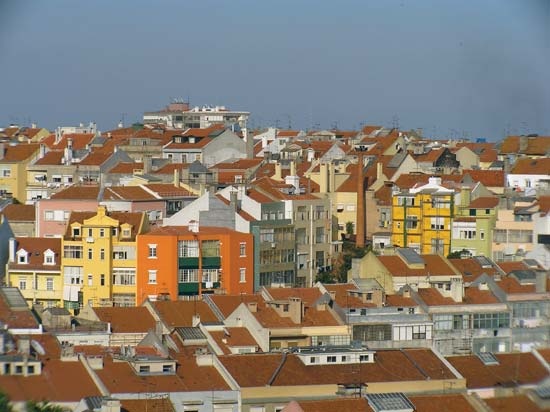 To the north, the transition between the city and the suburb is not marked. Vast shopping complexes such as Amoreiras and Colombo, along with residential apartment buildings, stretch north and northwest from the Marquês de Pombal Circle. These modern, colourful, mid-rise structures were designed by Lisbon architects.
To the north, the transition between the city and the suburb is not marked. Vast shopping complexes such as Amoreiras and Colombo, along with residential apartment buildings, stretch north and northwest from the Marquês de Pombal Circle. These modern, colourful, mid-rise structures were designed by Lisbon architects.Suburban development affected the city's character starting in the second half of the 20th century, when Lisbon lost about half its population because of migration to the periphery. New housing developments replaced manufacturing plants in Greater Lisbon. In the north, near the University of Lisbon (Lisbon, University of) campus, two neighbourhoods, Alvalade (which sprouted in the 1940s and 1950s) and Telheiras (which developed from the 1970s to the 1990s), were among the most successful examples of urban planning in the 20th century. Many affluent families have moved out of the city to newer gated communities or to villas in Greater Lisbon, mostly to the surrounding regions of Oeiras, Cascais, and Sintra.
People
Although the Lisbon metropolitan area occupies only about 3 percent of Portugal's total area, more than one-fourth of the country's inhabitants reside there. Lisbon experienced a population surge in the 1970s owing to migration (human migration) from the country's rural areas as well as the return of Portuguese citizens who had been living in Portugal's African colonies, which attained independence in 1975. Migration rates stabilized in the 1980s. In the mid-1990s, however, Africans, mainly from Cape Verde, were the most populous immigrant group; with a birth rate considerably higher than the national average, they contributed to a renewed growth of the population.
At the beginning of the 21st century, the foreign population accounted for about one-tenth of Lisbon residents. In addition to those from Cape Verde, immigrants arrived from Brazil, Angola, Guinea-Bissau, and various European countries. There are also smaller South Asian communities in the city proper and metropolitan area. Although this migratory current has put a strain on the city's resources, Lisbon's mixed population has transformed the city into a cosmopolitan and dynamic metropolis.
Economy
Lisbon's economy has historically been based on the fishing industry. Since the 1970s other industries have migrated from the Baixa to other locales in the metropolitan area. Following the 1975 revolution, Lisbon's heavy industries were nationalized. By the 1980s they were reprivatized, with multinational companies dominating the technology and pharmaceutical industries. Since the 1990s services have become the dominant economic activity of Lisbon.
Manufacturing
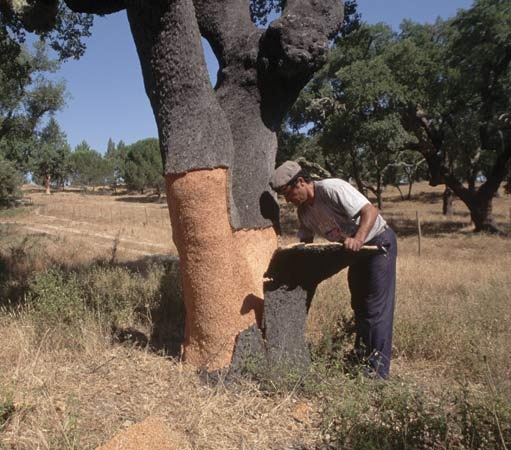 Heavy industry (i.e., shipbuilding, steelworks, and oil refining) has become obsolete; however, plants were modernized to produce automotive parts, chemicals, electronics, tobacco, paper, and foodstuffs. Since the 1990s, foreign-owned automotive assembly and food production plants have opened in newly constructed industrial centres in the metropolitan area. Traditional industries such as cork and textiles have maintained their competitiveness through technological innovation, however.
Heavy industry (i.e., shipbuilding, steelworks, and oil refining) has become obsolete; however, plants were modernized to produce automotive parts, chemicals, electronics, tobacco, paper, and foodstuffs. Since the 1990s, foreign-owned automotive assembly and food production plants have opened in newly constructed industrial centres in the metropolitan area. Traditional industries such as cork and textiles have maintained their competitiveness through technological innovation, however.Finance and other services
Service activities dominate the Lisbon economy, employing more than three-fourths of the labour force. Tourism and commerce have played a major part in Lisbon's modernization, and revenues from tourism have helped offset usually negative national trade balances. The 1998 World's Fair and the impressive waterfront renovation have contributed significantly to a new image of Lisbon. The fair sparked a radical renewal of the most derelict areas of the city. Slaughterhouses, waste treatment centres, and oil refineries have given way to recreational and health centres, museums, hotels, and new housing. Lisbon's temperate climate, nearby beaches, castles, and historic districts attract a significant number of tourists each year, and the city is a popular port of call for cruise ships. Several foreign bank branches operate in the city. Since Portugal's entrance into the European Community (now embedded in the European Union) in 1986, there has been an increase in the number of foreign financial institutions and corporations in Lisbon. Large retail outlets and department stores have opened in the Baixa and on the periphery of the Lisbon city centre.
Transportation
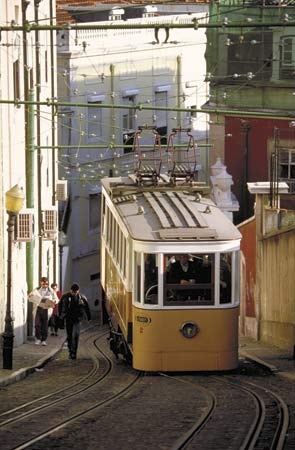 Lisbon is connected by rail and road to the interior of Portugal and to the rest of Europe. The 1.5-mile- (2.4-km-) long 25th of April Bridge, one of the longest suspension bridges in western Europe, has served as the main roadway into the city since it was built in the mid-1960s. Inaugurated in 1998, just in time for the World's Fair, the cable-stayed, combined-purpose Vasco da Gama Bridge, connecting Lisbon and the eastern portion of the metropolitan area to the southern shore, relieved traffic congestion on the 25th of April Bridge and provided additional rail access. A number of other public- and private-funded improvements to the city's transportation infrastructure were undertaken in the1990s in preparation for the fair. Notably, a new subway line was added to the system whose first route opened in 1959, and the trolley system in the historic district that primarily served tourists was refurbished and expanded. Also expanded and modernized was the airport at Portela de Sacavém, some 6 miles (10 km) northeast of the city centre, which offers flights to Europe, the Americas, and Africa. The construction of new highways and underground parking lots increased automobile usage, however, and the abundance of cars increased traffic and pollution in the city.
Lisbon is connected by rail and road to the interior of Portugal and to the rest of Europe. The 1.5-mile- (2.4-km-) long 25th of April Bridge, one of the longest suspension bridges in western Europe, has served as the main roadway into the city since it was built in the mid-1960s. Inaugurated in 1998, just in time for the World's Fair, the cable-stayed, combined-purpose Vasco da Gama Bridge, connecting Lisbon and the eastern portion of the metropolitan area to the southern shore, relieved traffic congestion on the 25th of April Bridge and provided additional rail access. A number of other public- and private-funded improvements to the city's transportation infrastructure were undertaken in the1990s in preparation for the fair. Notably, a new subway line was added to the system whose first route opened in 1959, and the trolley system in the historic district that primarily served tourists was refurbished and expanded. Also expanded and modernized was the airport at Portela de Sacavém, some 6 miles (10 km) northeast of the city centre, which offers flights to Europe, the Americas, and Africa. The construction of new highways and underground parking lots increased automobile usage, however, and the abundance of cars increased traffic and pollution in the city.Administration and society
Government
As the capital of Portugal, Lisbon and its surrounding suburbs house all of the country's principal government institutions. Lisbon is divided administratively into concelhos (municipalities). The municipalities are further divided into bairros (wards) and freguesias (parishes). Representatives to parish assemblies are chosen through local elections for four-year terms. They then elect an executive body, the parish committee. Lisbon's municipal assembly consists of representatives chosen by their parish committees and members directly elected by the local citizens. It serves as the legislative branch of local government and elects the executive branch, the municipal council and the mayor. The municipalities of Lisbon city and its metropolitan area constitute the distrito (district) of Lisbon, which is headed by a civil governor, who is appointed by and responsible to the central government through the minister of the interior.
Health
As a major urban centre, Lisbon has a higher percentage of doctors and other health professionals than the rest of Portugal. The city's hospitals include state, private, and military establishments. Since the 1990s, efforts have been made to modernize the city's public hospitals, and branches of larger hospitals have opened in other areas of the city.
Education
Officially, education in Portugal is free and compulsory for children ages 6 through 15. In addition to public schools, Lisbon has many private schools, including American, French, German, Spanish, and Swedish schools.The medieval University of Lisbon (Lisbon, University of) was founded in 1288 and remained Portugal's only university until the 16th century. It moved back and forth between Lisbon and Coimbra several times before settling in Lisbon from 1377 to 1537, when it permanently relocated to Coimbra and took the name of that city. Thus, the capital was left without a university until 1911, when the University of Lisbon was restored. The Technical University of Lisbon was founded in 1930, and the New University of Lisbon opened in the city during the 1970s. The Catholic University of Portugal was established under the tutelage of the Roman Catholic Church in 1968. Lisbon also has a large number of specialized colleges and polytechnical institutes. Prior to the 1974 coup in Portugal, university education was restricted to the elite. Not until the 1990s did the number of university applicants increase, and then, after a brief flourishing of private universities, student applications decreased again in the 2000s. Many Portuguese students have chosen to study abroad, especially in the United Kingdom, while a number of new immigrants have opted to enter the workforce rather than pursue higher education.
Cultural life
Lisbon's rich cultural life was further enhanced in the 1990s by the city's preparations for hosting the World's Fair, including the construction of the Belém Cultural Centre (1992), which offers visual and performing arts and houses exhibits, an auditorium, and an arts complex. It is but one component of the city's network of cultural centres, public libraries, and research institutes. Another prominent cultural institution, the Calouste Gulbenkian Foundation and Museum, presents music and ballet, exhibits other fine arts, and displays the broad-ranging personal collection of its eponymous benefactor, an Armenian oil-lease negotiator who lived in Lisbon from 1942 until his death in 1955. Culturgest, a multifunctional auditorium and exhibition centre, opened in Lisbon in the early 2000s.
The city has many other museums, including those dedicated to modern, antique, sacred, decorative, and folk arts. Two specialized, rather unusual museums are the Azulejo Museum and the National Museum of Coaches. The former, located in the convent of Madre de Deus, boasts a large and varied collection of the painted tiles (azulejos (azulejo)) for which the Iberian Peninsula is famous. The National Museum of Coaches occupies a wing of the Portuguese president's official residence and contains an impressive display of carved and gilded coaches.
Lisbon's municipal orchestra was founded in 1971. The city is also the site of the National Conservatory, which offers advanced instruction in both music and drama. The St. Charles and the National Theatre of Dona Maria II are Lisbon's two principal theatres. The former, which was constructed in the late 18th century, has a beautiful elliptical interior, and the latter, which was built about 1845, displays a facade of six giant columns saved from the convent church of St. Francisco, which was destroyed by an earthquake. The interior, gutted by fire in 1966, has been restored.
Neither of these edifices is as theatrical as the interiors of some of the churches built or restored after the 1755 earthquake. In gold, marble, carved wood, and rare tiles, these interiors are decorated in Baroque, Rococo, or rocaille style. One outstanding example is the 16th-century church of St. Roque, whose unpretentious exterior belies its opulent collection of painted tiles, paintings, and mosaics inlaid with semiprecious stones.
 The city's old red-brick bullring (bullfighting), Campo Pequeno, with its Moorish arches and cupolas, draws natives and tourists alike to witness the Portuguese manner of bullfighting. Campo Pequeno reopened in 2006 after a major renovation, which included the addition of a shopping mall, cinema, restaurants, and a supermarket.
The city's old red-brick bullring (bullfighting), Campo Pequeno, with its Moorish arches and cupolas, draws natives and tourists alike to witness the Portuguese manner of bullfighting. Campo Pequeno reopened in 2006 after a major renovation, which included the addition of a shopping mall, cinema, restaurants, and a supermarket.Lisbon is distinguished as one of the few places in the world whose chief Roman Catholic clergyman bears the title of patriarch. However, Lisboetas are typically less devout than the northern Portuguese and attend church mainly for rites such as christenings, weddings, and funerals. Religious processions are generally subdued affairs, without the colour and the drama found in Spain. The June feasts of the popular saints (St. Anthony, St. John, and St. Peter) are exceptions. Lisboetas celebrate them by donning imaginative costumes, jumping over bonfires, and dancing in the streets until dawn. Indeed, these lively events, held in the city's historical districts, retain all the pagan elements of a midsummer festival.
Lisbon has several sports and recreational areas. Many of the housing developments are planted with trees and grass, their small parks adding to Lisbon's collection of dozens of public gardens. The largest public park, Monsanto, covers about 3.5 square miles (9 square km) and has numerous recreational facilities. Rolling hills planted from the 1930s provide a windbreak for the city and are now thickly forested. There are also botanical gardens and a zoo within the city. Football (soccer) is very popular in Portugal, and three of the country's most prominent teams call Lisbon home: FC Porto, Benefica, and the Sporting Club of Lisbon.
History
The early period
Prehistoric to Moorish times
The valley in which the heart of Lisbon now lies was, in prehistoric times, the bed of a forked branch of the Tagus River. (The subway now forks at the same spot.) No evidence has been uncovered to show who were the first residents on the hills surrounding the valley. Although it seems likely that the city was founded about 1200 BC as a trading station by the far-ranging Phoenicians, there is no unassailable proof of the story. The city's ancient name, Olisipo (Ulyssipo), may be derived from the Phoenician alis ubbo (“delightful little port”) or from the legend that the city's founder was Odysseus.
Whatever the city's origins, it is known that the area was under Roman domination from 205 BC to about AD 409 and that Julius Caesar raised the settlement to the dignity of a municipium and named it Felicitas Julia. A few inscribed stones remain as evidence of the Roman presence. The Romans lost the city to the migratory peoples known as the Alani, who were driven out by the Suebi, who in turn were conquered by the Visigoths (Visigoth). The base plan of the original fortifications is thought to be Visigothic and, if so, is the sole vestige of their reign.
The Muslims (Islāmic world) of North Africa (Moors (Moor)) took Lisbon when they overran the Iberian Peninsula in the 8th century; they stayed for 433 years, despite incursions by the Normans (Norman) and by Alfonso VI of Castile and León in 1093. Under the Moors the city was known by variations of the name “Lisbon”: Luzbona, Lixbuna, Ulixbone, and Olissibona.
The Portuguese conquest
Behind their walls, the Moors (Moor) were able to hold out for months when the city was assailed by Crusader forces—English, Flemish, Norman, and Portuguese under Afonso I (Afonso Henriques) (Afonso I), the Portuguese king. The city finally fell in 1147 and then successfully resisted Moorish attempts to win it back. The Moorish alcazar was transformed into a Portuguese royal palace, and, according to legend, the Lisbon Cathedral (Sé Patriarcal) was converted from a mosque (with subsequent restorations in the styles of many periods after fires and earthquakes). There is no evidence, however, of a building on the site of the cathedral before the time of Afonso I.
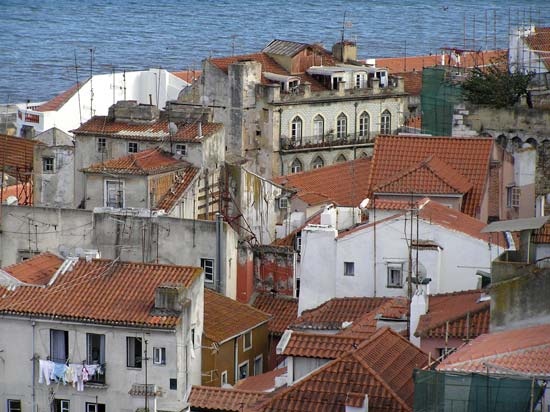 After winning Lisbon, King Afonso established his court 105 miles (170 km) to the north-northeast, atop a cliff at Coimbra. Lisbon did not become the national capital until more than a century later, in 1256. Within its Moorish walls, of which large segments still remain, medieval Lisbon measured 1,443 feet (440 metres) at its widest point and 1,984 feet (605 metres) at its longest, descending the hill below the castle. Even before the Portuguese conquest, two districts had already been built outside the walls: Alfama to the east and Ribeira to the west.
After winning Lisbon, King Afonso established his court 105 miles (170 km) to the north-northeast, atop a cliff at Coimbra. Lisbon did not become the national capital until more than a century later, in 1256. Within its Moorish walls, of which large segments still remain, medieval Lisbon measured 1,443 feet (440 metres) at its widest point and 1,984 feet (605 metres) at its longest, descending the hill below the castle. Even before the Portuguese conquest, two districts had already been built outside the walls: Alfama to the east and Ribeira to the west.King Dinis I (Dinis) (1279–1325) founded the University of Lisbon in 1288, and during his reign other hilltops around the central valley were crowned with convents and churches.
In 1372–73 Lisbon was besieged and burned by the Castilians, who forced King Ferdinand I (Ferdinand I), an unsuccessful contender for the Castilian throne, to repudiate his alliance with England; thereafter the king swiftly erected new defenses. His wall—more than 3 miles (5 km) long, with 77 towers and 38 gates and enclosing more than 247 acres (100 hectares)—withstood the renewed Castilian attack of 1384, which followed Ferdinand's death.
The Age of Discovery
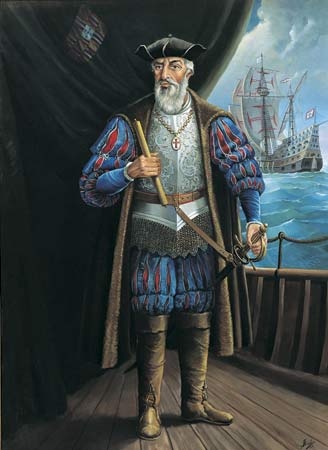 The first Portuguese census (1527) counted 65,000 inhabitants in Lisbon occupying 23 parishes. A considerable number of these residents became rich, and the city was endowed with larger and more luxurious buildings. African slaves became a familiar Lisbon sight, the trade in slaves being one in which Portugal played a major role. After the great explorer Vasco da Gama (Gama, Vasco da) led a Portuguese fleet to India in 1498, the Venetian monopoly on Oriental trade was broken, and colonies of German, Flemish, Dutch, English, and French traders established themselves in Lisbon. Greeks, Lombards, and Genoese who had lost their trading enclaves in Constantinople when that city fell to the Turks in 1453 also came to Lisbon.
The first Portuguese census (1527) counted 65,000 inhabitants in Lisbon occupying 23 parishes. A considerable number of these residents became rich, and the city was endowed with larger and more luxurious buildings. African slaves became a familiar Lisbon sight, the trade in slaves being one in which Portugal played a major role. After the great explorer Vasco da Gama (Gama, Vasco da) led a Portuguese fleet to India in 1498, the Venetian monopoly on Oriental trade was broken, and colonies of German, Flemish, Dutch, English, and French traders established themselves in Lisbon. Greeks, Lombards, and Genoese who had lost their trading enclaves in Constantinople when that city fell to the Turks in 1453 also came to Lisbon.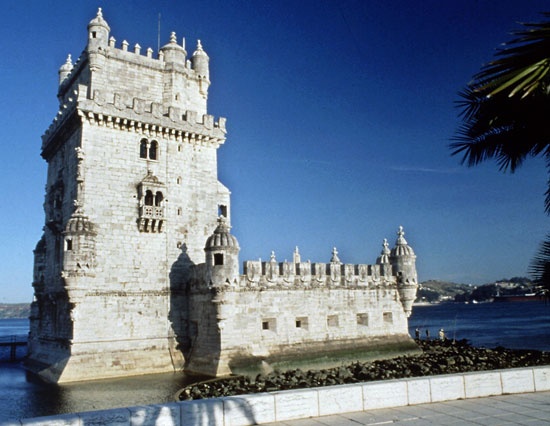 King Manuel I (Manuel I) (1495–1521) dominated this epoch, and under his rule Portugal developed its sole contribution to European architecture, an extreme style of late Gothic decoration that celebrated the voyages of discovery, Manuel, and God. The prime examples of Manueline style (Manueline) in Lisbon, the Tower of Belém, designated a World Heritage site in 1983, and the Jerónimos Monastery, about 4 miles (6 km) downstream from the city centre, are far less exuberant than those in the rival Portuguese cities of Batalha and Tomar. The tower and the monastery are nevertheless the most important architectural monuments in the Lisbon area. The five-story Tower of Belém, located on the riverbank, was built in 1515 as a fort in the middle of the Tagus, which subsequently altered course. Girt by a cable carved in the stone, it has a stern Gothic interior but exhibits North African touches on its turrets and crenellations and presents rounded Renaissance arches for the windows. The monastery with its church and cloisters was begun in 1502 by Diogo de Boytac (Boitaca), an architect of French origin, and was not finished until the end of the century. Four other architects worked on the project, their styles passing from the Gothic through the Renaissance to the Baroque. Smoothed by time, the ensemble is harmonious and proudly Portuguese.
King Manuel I (Manuel I) (1495–1521) dominated this epoch, and under his rule Portugal developed its sole contribution to European architecture, an extreme style of late Gothic decoration that celebrated the voyages of discovery, Manuel, and God. The prime examples of Manueline style (Manueline) in Lisbon, the Tower of Belém, designated a World Heritage site in 1983, and the Jerónimos Monastery, about 4 miles (6 km) downstream from the city centre, are far less exuberant than those in the rival Portuguese cities of Batalha and Tomar. The tower and the monastery are nevertheless the most important architectural monuments in the Lisbon area. The five-story Tower of Belém, located on the riverbank, was built in 1515 as a fort in the middle of the Tagus, which subsequently altered course. Girt by a cable carved in the stone, it has a stern Gothic interior but exhibits North African touches on its turrets and crenellations and presents rounded Renaissance arches for the windows. The monastery with its church and cloisters was begun in 1502 by Diogo de Boytac (Boitaca), an architect of French origin, and was not finished until the end of the century. Four other architects worked on the project, their styles passing from the Gothic through the Renaissance to the Baroque. Smoothed by time, the ensemble is harmonious and proudly Portuguese.Manuel I promoted the urbanization of Lisbon, creating new districts, and by the Tagus he constructed the Ribeira Palace, with a large square laid out along its eastern flank. The area between the Rossio and the Palace Terrace was soon crisscrossed with streets, along which rose the new shops, churches, and hospitals of what had become a phenomenally prosperous city. Although Lisbon suffered a serious earthquake in 1531 and some sanitary problems, its development was not hampered, and it advanced with new prestigious construction, mainly along the Tagus River.
The prosperity was chimerical, however. John III (the Pious) (John III), who had succeeded Manuel, permanently transferred (1537) the university to the royal palace at Coimbra, far from the capital's excesses. He also invited the Jesuits (Jesuit) and the inquisition to come to Portugal. The inquisition office, located in the Rossio, was particularly ferocious in its persecution of the Jews, who were the bankers, financiers, and moneylenders of the time. Many wealthy Jews had their property and goods confiscated; some emigrated to Holland or other countries, taking their money and financial expertise with them. As a result, Lisbon's connections with foreign markets were disrupted and the country's economy suffered severe financial constraints.
In 1578 King Sebastian (Sebastian) of Portugal was killed in a disastrous invasion of Morocco: two years later, the Spanish pushed into Portugal, and Philip II of Spain became king of both countries. In 1588 it was from Lisbon that the Invincible Armada sailed against England, Portugal's oldest ally. In the half century that followed, Lisbon lived relatively well as a port for the riches of the Spanish Main. In 1640 a conspiracy of Lisbon nobles struck for freedom and drove out the Spaniards, restoring Portugal's independence. Restoration Square, just north of Rossio Square, is named for them.
With the Cromwellian treaty of 1654, following British military assistance to the Portuguese in the war with Spain, the British merchants trading and living in Lisbon set up a corporation, which became known as the British Factory. The Factory negotiated with the Portuguese government for trade concessions and other privileges, appealing to the British government to put pressure on the Portuguese authorities when necessary. Britain's economic and political influence on Portugal was strong, and the Factory remained in existence until 1810.
Evolution of the modern city
Disaster and reconstruction
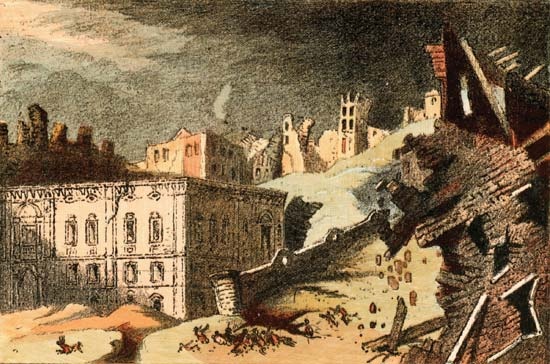 In the first half of the 18th century, the profits from the plantations and the gold and diamond deposits of Brazil brought a new flurry of optimism and excitement to Lisbon. Meanwhile, an aqueduct was being built and manufacturing was flourishing. During this time of financial prosperity, churches also were constructed, namely the massive convent of Mafra, about 25 miles (40 km) north of Lisbon. This period of optimism ended on the morning of Nov. 1, 1755. The churches were crowded to honour the dead on All Saints' Day when the city was devastated by one of the greatest earthquakes (earthquake) ever recorded. Three initial jolts lasted for 10 minutes. Lisbon's quay sank into the Tagus River. Those who sought safety on boats on the Tagus were drowned by a tsunami. Following the tsunami, massive fires broke out and lasted for days, burning large sections of the city. About 60,000 lives were lost, and more than 12,000 buildings were destroyed. (See Lisbon earthquake of 1755.)
In the first half of the 18th century, the profits from the plantations and the gold and diamond deposits of Brazil brought a new flurry of optimism and excitement to Lisbon. Meanwhile, an aqueduct was being built and manufacturing was flourishing. During this time of financial prosperity, churches also were constructed, namely the massive convent of Mafra, about 25 miles (40 km) north of Lisbon. This period of optimism ended on the morning of Nov. 1, 1755. The churches were crowded to honour the dead on All Saints' Day when the city was devastated by one of the greatest earthquakes (earthquake) ever recorded. Three initial jolts lasted for 10 minutes. Lisbon's quay sank into the Tagus River. Those who sought safety on boats on the Tagus were drowned by a tsunami. Following the tsunami, massive fires broke out and lasted for days, burning large sections of the city. About 60,000 lives were lost, and more than 12,000 buildings were destroyed. (See Lisbon earthquake of 1755.)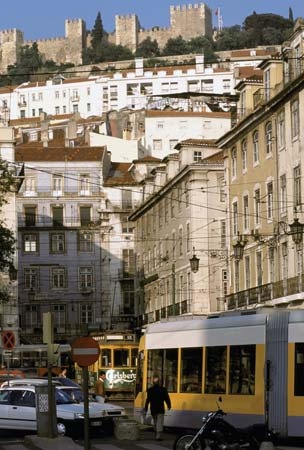 Physically, Lisbon recovered with a celerity astonishing for the time, but the shock left its mark upon the thinking of generations to come. The reconstruction—a good deal of foreign aid was forthcoming—was achieved by Joseph I's prime minister, Sebastião José de Carvalho (Pombal, Sebastião de Carvalho, marquês de), the virtual ruler of the country. He put Manuel da Maia, engineer in chief of the realm, in charge of five architects and soon had a plan for remaking the totally devastated centre of the Cidade Baixa (“Lower City”). The riverside palace had been destroyed, and its terrace was expanded to create the new Commerce Square. Northward from there, a grid of 48 streets led inland to the Rossio and a neighbouring new square, Figueira. The two-story, uniform buildings were topped by two tiers of dormers projecting from tiled roofs. The corners of the eaves, in the Lisbon tradition, turned up, in faint echo of a pagoda. The building style, evolved for fast, cheap construction, was Baroque but virtually stripped of decoration. After the minister was rewarded with the title of marquês de Pombal, the style became known as pombalino.
Physically, Lisbon recovered with a celerity astonishing for the time, but the shock left its mark upon the thinking of generations to come. The reconstruction—a good deal of foreign aid was forthcoming—was achieved by Joseph I's prime minister, Sebastião José de Carvalho (Pombal, Sebastião de Carvalho, marquês de), the virtual ruler of the country. He put Manuel da Maia, engineer in chief of the realm, in charge of five architects and soon had a plan for remaking the totally devastated centre of the Cidade Baixa (“Lower City”). The riverside palace had been destroyed, and its terrace was expanded to create the new Commerce Square. Northward from there, a grid of 48 streets led inland to the Rossio and a neighbouring new square, Figueira. The two-story, uniform buildings were topped by two tiers of dormers projecting from tiled roofs. The corners of the eaves, in the Lisbon tradition, turned up, in faint echo of a pagoda. The building style, evolved for fast, cheap construction, was Baroque but virtually stripped of decoration. After the minister was rewarded with the title of marquês de Pombal, the style became known as pombalino.The Sé and most of the churches were repaired or rebuilt, but the 14th-century Carmel (Carmo) Church was left as it was. Looming from its hilltops over the Baixa, the roofless Gothic shell was converted into an archaeological museum, while its cloister served as the barracks for the National Republican Guard, a paramilitary security force. The Palace of the Inquisition, utterly flattened, was not rebuilt when Pombal enlarged and realigned the Rossio, and on its site, 90 years later, the National Theatre of Dona Maria II was erected. Pombal banished the Jesuit order and transformed their establishment into St. Joseph's Hospital to replace the destroyed All Saints Hospital. The medical school scrambled for room at St. Joseph's until it acquired a new building of its own late in the 19th century. The Jesuit novice house was converted to serve as the Nobles' School. Later governments expelled more religious orders, whose buildings became barracks, hospitals, royal academies, and government offices.
19th-century expansion
During the Peninsular War of the early 1800s, Lisbon alternated between French and British control. When Napoleon (Napoleon I) invaded Portugal in 1807, the Portuguese royal family fled to Rio de Janeiro in Brazil. Rio replaced Lisbon as the capital of the Portuguese empire from 1808 to 1821, which enabled Portugal to maintain its independence. The war was followed by 10 years of revolutionary outbursts in Lisbon as liberal constitutionalists and absolutists fought over succession to the throne. Nevertheless, 19th-century Lisbon continued to expand and, by 1885, embraced some 20,378 acres (8,250 hectares), while the population had doubled in 100 years to reach 300,000. Public buildings, such as the new city hall and the Ajuda Royal Palace, had been built, and the harbour had been modernized and quays constructed on land reclaimed from the river. The railway had appeared, and a system of horsecars served the Baixa.
The greatest change in the city, and the one most important for modern expansion, was the opening in 1880 of a new main street—Avenida da Liberdade. The municipality bordered the central six-lane carriageway with wide blue mosaic sidewalks graced with palms and shade trees, fountains, and ornamental waters stocked with goldfish and swans. The street remained the same through the 20th and into the 21st century, with the addition of outdoor cafés beneath the trees.
In conjunction with the new thoroughfare, a series of avenidas novas (“new streets”) expanded the city northward, and new neighbourhoods developed like those that bordered Avenida da Liberdade. In 1901 the electric streetcar made its appearance, enabling more people to live farther away from their employment in the Baixa. Three cable cars shuttled up and down the adjacent hills, and the giant elevator designed by French architect Raoul Mesnier du Ponsard hissed grandly between the city's upper and lower levels.
New water supplies, augmenting those of the 18th-century aqueduct of Águas Livres, were introduced from Alviela. Consequently, water was piped directly into houses, eliminating the hassle of having to call a water porter.
The 20th century
In 1906 Portugal's King Charles appointed João Franco as prime minister and allowed him to assume dictatorial powers, a decision that was met by strong opposition. On the morning of Feb. 1, 1908, a newspaper reported that a new law had gone into effect calling for the deportation to Africa of anyone who opposed the policies of the monarch. That afternoon Charles and the crown prince were assassinated by anarchists on the northwest corner of Commerce Square. That same day, Manuel, the king's younger son, ascended to the Portuguese throne as Manuel II. The new king vowed to uphold the constitution and destroy his father's oppressive regime. Two years later Manuel II abdicated. A republic was declared, and a period of national instability ensued. When António de Oliveira Salazar (Salazar, António de Oliveira) took control of the near-bankrupt country in 1932, he established a corporate state for which he alone determined the policies until his retirement in 1968. There was considerable growth in Lisbon throughout this time. New industries emerged, and oil and petrochemical refineries were constructed. Electrical and metal manufactures were mass-produced. Ports, roads, and railways were modernized, and housing projects, colleges, hospitals, and sports arenas were built.
During the world wars the city was able to offer refuge to some 200,000 foreigners. Until the end of World War I, urban expansion followed the pattern of broad avenues established in Paris in the mid-19th century by Georges-Eugène Haussmann (Haussmann, Georges-Eugène, Baron). After the war, city extensions became more functional, though the new street patterns were relatively uncharacteristic, dominated by big highways and the absence of a coherent urban design.
In the 1960s national policy began to change, allowing economic expansion. The 30-year-old austerity program of stability and self-sufficiency (at an admittedly low level of investment and consumption) was somewhat softened, and tourists and foreign corporations began to be accommodated. In 1966, well ahead of schedule, the Salazar (now the 25th of April) Bridge was completed.
On April 25, 1974, the government of Marcello Caetano (Caetano, Marcello José das Neves Alves), Salazar's successor, was overthrown by a military coup. By the early 1980s, however, political instability and economic difficulties remained serious problems and hindered the country's—and the city's—efforts to bring about social and economic reforms. The restriction of government funds for the municipality of Lisbon led to a bitter struggle within the city council, where resistance mounted to speculative building projects that would affect the environment in historical parts of the city.
In 1986 Portugal's integration into the European Communities (see European Community) stimulated modernization in Lisbon, and private investment contributed to the construction of new buildings. The World's Fair in 1998 spurred the modernization of the city's infrastructure, increased tourism, and stimulated economic growth. In the early 2000s, however, Portugal experienced economic stagnation, and its economic development fell behind that of other European countries. Lisbon fared better than other cities in the country, however, and, along with tourists, it has continued to attract foreign and real estate investment.
Additional Reading
General works
David Wright and Patrick Swift, Lisbon: A Portrait and a Guide (1971), gives thorough coverage of all quarters of the city—its history, monuments, cultural institutions, and contemporary life—and also includes excursions outside Lisbon. Carol Wright, Lisbon (1971), discusses the city and the life of its inhabitants at various times of day, as well as providing information for the visitor to Lisbon and its environs. Vivian Rowe, The Road to Lisbon (1962), is mainly concerned with the journey from France to Lisbon but includes material on the attractions of the city itself. Also informative are Jorge Gaspar, “Lisbon: Metropolis Between Centre and Periphery” in Chris Jensen-Butler, Arie Shachar, and Jan van Weesep, European Cities in Competition (1997), pp. 147–178, a discussion on the economic challenges faced by Lisbon in the context of the European Union, and The Regions of Portugal (1993; originally published in Portuguese, 1993), a survey of Portuguese regions that includes Lisbon and its metropolitan area, with illustrations.
History
Damião de Góis, Lisbon in the Renaissance, trans. by Jeffrey Ruth (1999), is de Góis's description of Lisbon in 1554 at the peak of its commercial and cultural development. Henry Fielding, The Journal of a Voyage to Lisbon, ed. by Ian A. Bell and Andrew Varney (1996), recounts the novelist and playwright's 18th-century journey to Lisbon just before his death. Other works of interest include Thomas D. Kendrick, The Lisbon Earthquake (1956), a study of the 1755 earthquake and its impact on European philosophers and theologians; Janet Schaw, Journal of a Lady of Quality: Being the Narrative of a Journey from Scotland to the West Indies, North Carolina, and Portugal, in the Years 1774–1776, 3rd ed. edited by Evangeline Walker Andrews and Charles McLean Andrews (1939, reissued 1971); Rose Macaulay, They Went to Portugal (1946, reissued 1985), on the British in Portugal; Tom Gallagher, Portugal: A Twentieth-Century Interpretation (1983); and Richard A.H. Robinson, Contemporary Portugal: A History (1979).
- Kama
- kamacite
- Kamaishi
- Kamakura
- Kamakura-bori
- Kamakura period
- Kamala Markandaya
- kamanjā
- Kamaraj, Kumaraswami
- Kamarhati
- Kama River
- Kamarupa
- Kamarān
- Kamau Brathwaite
- Kamba
- Kambalda
- Kamban, Gudmundur
- Kamchatka
- Kamchatka Peninsula
- Kamchatka River
- kame
- Kamehameha I
- Kamehameha II
- Kamehameha III
- Kamehameha IV